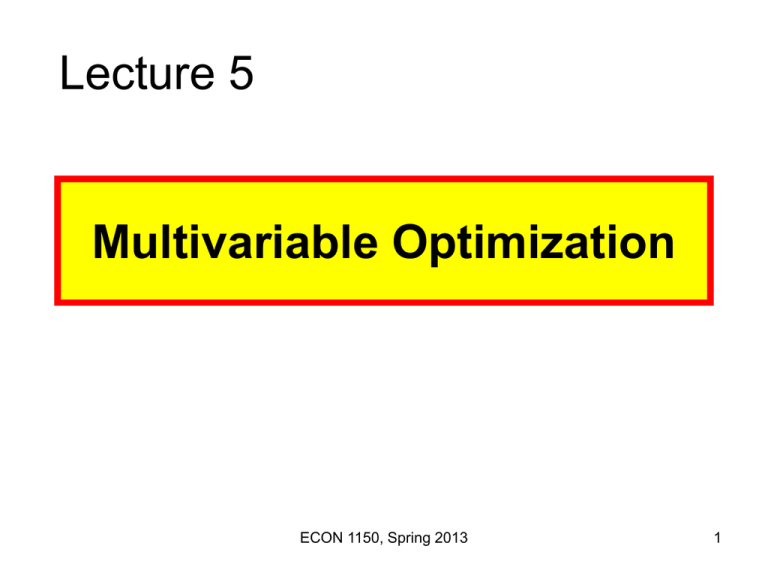Partial Differentiation
advertisement

Lecture 5 Multivariable Optimization ECON 1150, Spring 2013 1 1. Necessary Conditions Optimization problems: maxx1,x2 y = f(x1,x2) minx1,x2 y = f(x1,x2) E.g., profit maximization, cost minimization ECON 1150, Spring 2013 2 When x2 is kept constant, f(x1, c) is a function of x1 only. When x1 is kept constant, f(c, x2) is a function of x2 only First-order conditions for a stationary point y x n x1 x1* ,x 2 x 2* f x , x * 1 x n * 2 0, ECON 1150, Spring 2013 n = 1,2. 3 Example 5.1: Find stationary values of the following functions: (a) y = 2x1² + x2²; (b) y = 4x1² - x1x2 + x2² - x1³. ECON 1150, Spring 2013 4 Possible cases of stationary points ECON 1150, Spring 2013 5 2. Sufficient Conditions Second-order conditions for a local maximum at a point (SOC max) f11 < 0; f11·f22 – (f12)2 > 0 Second-order conditions for a local minimum at a point (SOC min) f11 > 0; f11·f22 – (f12)2 > 0. ECON 1150, Spring 2013 6 Classifying a stationary point If f1(x1*,x2*) = f2(x1*,x2*) = 0, then a. SOC max local maximum b. SOC min local minimum c. f11f22 – (f12)2 = 0 no conclusion d. f11f22 – (f12)2 < 0 saddle point ECON 1150, Spring 2013 7 Example 5.2: Identify the nature of the stationary points of the following function, y = f(x1,x2) = x1³ + 5x1x2 – x2². ECON 1150, Spring 2013 8 Example 5.3: Identify the nature of the stationary points of the following functions: a. f(x1,x2) = x12 + x24; b. f(x1,x2) = x12 – x24; c. f(x1,x2) = x12 + x23; d. f(x1,x2) = x14 + x24; ECON 1150, Spring 2013 9 If for all (x1,x2), f11 0 and f11f22 – (f12)2 0. then f(x1,x2) is a concave function. Example 5.4: Concave functions a. y = x1 + x2; b. y = x10.4x20.6 for positive x1 and x2; c. y = lnx1 + lnx2. ECON 1150, Spring 2013 10 If for all (x1,x2), f11 0 and f11f22 – (f12)2 0. then f(x1,x2) is a convex function. Example 5.5: Convex functions a. y = x1 + x2; b. y = 3x12 + 3x1x2 + x22. ECON 1150, Spring 2013 11 For a stationary point (x10, x20), concave function global maximum convex function global minimum Example 5.6: Show that the function f(x1,x2) = -2x12 – 2x1x2 – 2x22 + 36x1 + 42x2 – 158 is a concave function. Find the global maximum point. ECON 1150, Spring 2013 12 Remarks: a. 2nd order conditions hold at a point Local extremum b. 2nd order conditions hold for all points Global extremum c. SOC are sufficient, but not necessary ECON 1150, Spring 2013 13 3. Economic Applications A firm produces 2 different kinds A and B of a commodity. The daily cost of producing x units of A and y units of B is C(x,y) = 0.04x2 + 0.01xy + 0.01y2 + 4x + 2y + 500. Suppose that that firm sells all its output at a price per unit of 15 for A and 9 for B. Find the daily production levels x* and y* that maximize profit per day. ECON 1150, Spring 2013 14 Long-run profit maximization of a competitive firm Output price: 200 Inputs: K with a price of 42 L with a price of 5 Production function: 3.1K0.3L0.25. ECON 1150, Spring 2013 15 General profit maximization problem maxK,L (K,L) = pf(K,L) – wKK – wLL FOC: K(K,L) = pMPK – wK = 0 L(K,L) = pMPL – wL = 0 1. pMPn = wn (n = K,L) 2. wK / MPK = wL / MPL = p = MC 3. wK/wL = MPK/MPL = MRTS ECON 1150, Spring 2013 16 Profit maximization of a 2-product firm A two-product firm faces the demand and cost functions below: Q₁ = 40 - 2P₁ - P₂ Q₂ = 35 - P₁ - P₂ TC = Q₁² + 2Q₂² + 10 Find the profit-maximizing output levels and the maximum profit. ECON 1150, Spring 2013 17









